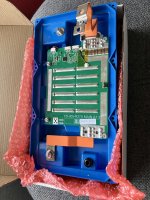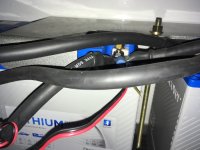Trail Talk
Well-known member
Our lithium battery (LiFePO4) learning continues...
During our summer travels, we noticed that one of our two Discover Blue 200Ah batteries was consistently discharging faster than the other. Using their BMS Bluetooth app, which reports individual cell voltages and total SOC, we found one was typically reporting 15-20% lower voltage despite checking that all the connections were proper and secure.
So once home I contacted Discover Energy's tech support and "connected" with a really patient technician. Unlike most other support platforms, from internet to insurance, I always deal with the same fellow. Also, unlike those disappearing chat windows, our full communications thread is always there to refer back to.
Recalling the over-voltage protection that was triggered on the same battery (see post #1), and after checking connections and settings, our tech feared the BMS may be bad. Since the BMS is a user-replaceable component with their design, he shipped out another with a link to an installation video.
After the new BMS was installed and both batteries fully charged to the same resting voltage, they went back into the cabin. Access to our battery compartment is through a smallish floor-level access hatch and I'm working on my back mostly so the weight advantage of the lithium over our old AGMs was much appreciated.
Apparently it will take some use and time for the battery app's SOC calculation to sync but I'll continue to rely on the Victron BMV-712 to monitor anyway. VictronConnect is really a fantastic app if you have multiple Victron components.
A bunch of other settings were adjusted as per Discover Blue's specs which were different from the Victron and Xantrex lithium battery defaults; absorption to 13.8V and float to 13.6V, tail current 2.5%, charge efficiency 99%, discharge floor at 15%, and finished by synchronizing the SOC reading to 100%. I also got around to creating a VE.Smart network with with MPPT solar charger so the BMV shares battery temperature and current readings. Annoyingly, for reasons unknown to anyone outside of Victron, they haven't enabled the Orion-Tr "Smart" DC to DC charger for VE.Smart networking!
We haven't travelled since the BMS swap but will do so in the near future. On shore power, the batteries are now maintaining an equal and full charge. I must confess to being a complete noob with electronics and batteries so the generous and patient support I've received from Discover Energy has been a godsend. Still, hoping not to need their services again ;-)
During our summer travels, we noticed that one of our two Discover Blue 200Ah batteries was consistently discharging faster than the other. Using their BMS Bluetooth app, which reports individual cell voltages and total SOC, we found one was typically reporting 15-20% lower voltage despite checking that all the connections were proper and secure.
So once home I contacted Discover Energy's tech support and "connected" with a really patient technician. Unlike most other support platforms, from internet to insurance, I always deal with the same fellow. Also, unlike those disappearing chat windows, our full communications thread is always there to refer back to.
Recalling the over-voltage protection that was triggered on the same battery (see post #1), and after checking connections and settings, our tech feared the BMS may be bad. Since the BMS is a user-replaceable component with their design, he shipped out another with a link to an installation video.
After the new BMS was installed and both batteries fully charged to the same resting voltage, they went back into the cabin. Access to our battery compartment is through a smallish floor-level access hatch and I'm working on my back mostly so the weight advantage of the lithium over our old AGMs was much appreciated.
Apparently it will take some use and time for the battery app's SOC calculation to sync but I'll continue to rely on the Victron BMV-712 to monitor anyway. VictronConnect is really a fantastic app if you have multiple Victron components.
A bunch of other settings were adjusted as per Discover Blue's specs which were different from the Victron and Xantrex lithium battery defaults; absorption to 13.8V and float to 13.6V, tail current 2.5%, charge efficiency 99%, discharge floor at 15%, and finished by synchronizing the SOC reading to 100%. I also got around to creating a VE.Smart network with with MPPT solar charger so the BMV shares battery temperature and current readings. Annoyingly, for reasons unknown to anyone outside of Victron, they haven't enabled the Orion-Tr "Smart" DC to DC charger for VE.Smart networking!
We haven't travelled since the BMS swap but will do so in the near future. On shore power, the batteries are now maintaining an equal and full charge. I must confess to being a complete noob with electronics and batteries so the generous and patient support I've received from Discover Energy has been a godsend. Still, hoping not to need their services again ;-)
Last edited:







